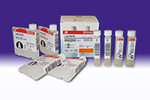Lactate reagent
Blood lactate concentration is directly related to the availability of oxygen: when the amount of oxygen is inadequate in cells and tissues (hypoxia), the anaerobic carbohydrate metabolism leads to lactic acidosis. So, lactic concentration is increased in any type of tissue hypoxia, such as severe congestive heart failure, shock of any etiology (septic, cardiogenic…), severe anemia or monoxide carbon intoxication. Lactic acidosis can also happen in favourable tissue oxygenation, as in leukemia and solid tumours where the cause may be excessive lactate production by the neoplastic tissue. Other causes include poorly controlled diabetes or severe hepatic insufficiency. Lactate levels may also increase during intense exercise, causing a transitory and benign lactic acidosis. A cerebrospinal fluid (CSF) lactate test may be ordered, along with a blood lactate test, to help distinguish between viral and bacterial meningitis. Increased levels also occur in any clinical condition associated with reduced oxygenation of brain and/or increased intracranial pressure. This new lactate reagent is based on the Lactate Oxidase/Peroxidase method, which is more convenient for random access–type equipment because of its long stability on board and lack of cross contamination when compared with the Lactate Dehydrogenase method.
Supplier: BioSystems
Website:



